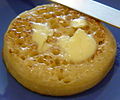Crumpet
Crumpet is a type of savoury or slightly sweet bread commonly enjoyed in the United Kingdom, Ireland, and in some parts of the Commonwealth. Made from a simple batter of water or milk, flour, and yeast, crumpets are known for their distinctive flat top with deep pores, and a chewy, sponge-like texture. They are traditionally cooked on a griddle or in a special crumpet ring that gives them their characteristic shape.
History[edit]
The origins of the crumpet are somewhat obscure, but it is believed to have been a staple in the British Isles since at least the Anglo-Saxon period. The modern crumpet, distinguished by its holes which are created by the aeration process during cooking, evolved from early forms of flatbreads that were cooked on hot stones. The term "crumpet" itself is thought to have derived from the Old English word "crompid," meaning "curled up," which possibly refers to its slightly curled edges that result from the cooking process.
Ingredients and Preparation[edit]
The basic ingredients of crumpets include wheat flour, baking powder or baking soda as a leavening agent, salt, and water or milk. Some recipes may also include sugar and eggs to enrich the batter. The key to the crumpet's unique texture is the batter's consistency, which is thicker than that of pancake batter but thinner than dough. Yeast is used to ferment the batter, creating the characteristic holes as it cooks.
To prepare crumpets, the batter is poured into greased crumpet rings placed on a hot griddle or frying pan. As the crumpet cooks, the top surface bubbles and sets, while the bottom becomes golden brown. Once the top is set and full of holes, the crumpet is flipped to cook briefly on the other side. Crumpets are typically served warm with butter, jam, or honey.
Cultural Significance[edit]
Crumpets hold a special place in British cuisine and are often associated with tea time, a quintessential British tradition. They are also a popular breakfast item, enjoyed with a variety of toppings. In addition to their culinary role, crumpets have made appearances in British literature and have come to symbolize comfort and homeliness in popular culture.
Variations[edit]
While the traditional crumpet is plain, there are several variations, including whole wheat crumpets, which use whole wheat flour for a nuttier flavor and higher fiber content. Some modern versions incorporate additional ingredients such as cheese, onion, or herbs to create savory variations. In some regions, crumpets may be confused with English muffins; however, the two are distinct, with English muffins being dough-based and cooked to a firmer texture.
Nutritional Information[edit]
Crumpets are relatively low in calories but can be high in carbohydrates due to their flour content. When topped with nutritious ingredients like fresh fruit or natural peanut butter, they can be part of a balanced diet. However, traditional toppings like butter and jam can add additional fat and sugar.
See Also[edit]
-
Crumpet
Ad. Transform your life with W8MD's Budget GLP-1 injections from $75


W8MD offers a medical weight loss program to lose weight in Philadelphia. Our physician-supervised medical weight loss provides:
- Weight loss injections in NYC (generic and brand names):
- Zepbound / Mounjaro, Wegovy / Ozempic, Saxenda
- Most insurances accepted or discounted self-pay rates. We will obtain insurance prior authorizations if needed.
- Generic GLP1 weight loss injections from $75 for the starting dose.
- Also offer prescription weight loss medications including Phentermine, Qsymia, Diethylpropion, Contrave etc.
NYC weight loss doctor appointmentsNYC weight loss doctor appointments
Start your NYC weight loss journey today at our NYC medical weight loss and Philadelphia medical weight loss clinics.
- Call 718-946-5500 to lose weight in NYC or for medical weight loss in Philadelphia 215-676-2334.
- Tags:NYC medical weight loss, Philadelphia lose weight Zepbound NYC, Budget GLP1 weight loss injections, Wegovy Philadelphia, Wegovy NYC, Philadelphia medical weight loss, Brookly weight loss and Wegovy NYC
|
WikiMD's Wellness Encyclopedia |
| Let Food Be Thy Medicine Medicine Thy Food - Hippocrates |
Medical Disclaimer: WikiMD is not a substitute for professional medical advice. The information on WikiMD is provided as an information resource only, may be incorrect, outdated or misleading, and is not to be used or relied on for any diagnostic or treatment purposes. Please consult your health care provider before making any healthcare decisions or for guidance about a specific medical condition. WikiMD expressly disclaims responsibility, and shall have no liability, for any damages, loss, injury, or liability whatsoever suffered as a result of your reliance on the information contained in this site. By visiting this site you agree to the foregoing terms and conditions, which may from time to time be changed or supplemented by WikiMD. If you do not agree to the foregoing terms and conditions, you should not enter or use this site. See full disclaimer.
Credits:Most images are courtesy of Wikimedia commons, and templates, categories Wikipedia, licensed under CC BY SA or similar.
Translate this page: - East Asian
中文,
日本,
한국어,
South Asian
हिन्दी,
தமிழ்,
తెలుగు,
Urdu,
ಕನ್ನಡ,
Southeast Asian
Indonesian,
Vietnamese,
Thai,
မြန်မာဘာသာ,
বাংলা
European
español,
Deutsch,
français,
Greek,
português do Brasil,
polski,
română,
русский,
Nederlands,
norsk,
svenska,
suomi,
Italian
Middle Eastern & African
عربى,
Turkish,
Persian,
Hebrew,
Afrikaans,
isiZulu,
Kiswahili,
Other
Bulgarian,
Hungarian,
Czech,
Swedish,
മലയാളം,
मराठी,
ਪੰਜਾਬੀ,
ગુજરાતી,
Portuguese,
Ukrainian

